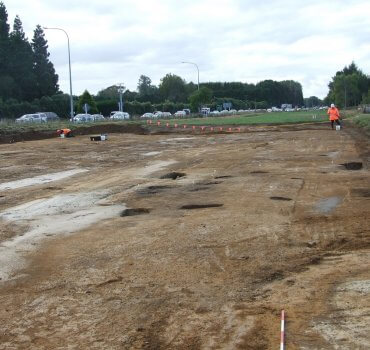

The historic site was uncovered during work for the new expressway.
Further evidence of an ancient Māori settlement at Tamahere was uncovered recently during expressway construction works.
It added to an historical record which began in 2015 before excavations for the Southern Interchange began, when evidence of large scale pre-European kumara gardening was found in the deer farm opposite Cherry Lane.
A second site was uncovered recently by construction staff opposite Bollard Road. Work stopped in the immediate area for two weeks while archaeologists investigated. They found evidence of small storage pits, a few larger storage pits, and small areas used for cooking, plus a small number of post holes, perhaps representing small or temporary structures. The evidence was spread quite widely over a large area.
Project Archaeologist Sian Keith said it was likely that the area had been used to store foodstuffs such as kumara. “This area was markedly different from the gardening area at the deer farm,” Keith said. “At the deer farm site there were a large number of small bowl-shaped pits, or puke, which were filled with sand and were for gardening, perhaps to raise kumara seedlings in the spring.”
In pre-European times, Māori would locate deposits of course sand to mix with topsoil, to improve the drainage and growing conditions for kumara.
The few post holes found at the site recently indicated these may have supported pataka – raised storehouses for kumara or other food. Scientific analysis of the soil samples removed will help to shed more light on the finding.
“We didn’t find neat rows of postholes that would indicate formal buildings, so it’s unlikely people lived here. And we didn’t find any significant artefacts,” Ms Keith says. The investigated area is close to known pā sites.
The information is being formally recorded and has been shared with local iwi as the work has progressed.
Construction of the Hamilton Section of the Waikato Expressway was back underway last week. The entire Hamilton section is expected to open in 2020.








